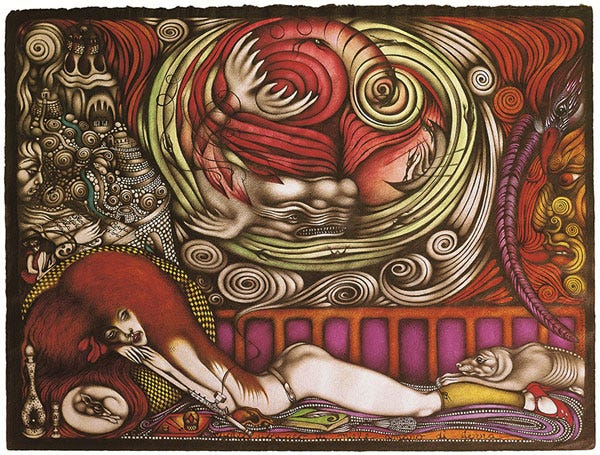Magic, Miracles, and Morphogenetic Fields
4th Essay in a Series

In this essay series (the earlier ones can be found here, here, and here), we are taking a relatively serious, or at the very least not tongue in cheek, look at “magic” or “miraculous intervention” as a possible means of responding to the all-engulfing ecological and geopolitical polycrisis. It does seem like we need something approaching a miracle, all things considered.
Instead of materialism or physicalism, I have put forth the idealist thesis that the universe is actually made out of consciousness. According to this theory, consciousness, rather than anything material or physical, is the ontological primitive, the foundation. If everything is ultimately a dreamlike projection of this underlying consciousness, then everything is, also, magic.
Consciousness projects the universe and explores its expressive possibilities through its creation. According to analytic idealism as well as ancient Vedanta, we are temporarily dissociated “alters” of this instinctive, unified field of consciousness, which can only experience itself by evolving separate beings — individuated containers of awareness — such as ourselves. This is why evolution reveals an anti-entropic tendency toward greater complexity and intelligence — as well as culture, technical innovation, etcetera.
We looked at Rupert Sheldrake’s theories of morphogenetic fields and morphic resonance. According to this hypothesis, the “laws” of nature are not eternally fixed and invariable. They change and evolve over time.
This idea is now haunting the edges of mainstream scientific discourse, due to deepening problems with the underlying theories about the origin and development of the universe, based on new evidence from astronomical observation. Last Saturday, The NY Times published “The Story of Our Universe May Be Starting to Unravel,” a guest essay by astrophysicist Adam Frank and physicist Marcelo Gleiser, responding to recent findings from the James Webb telescope that undermine the standard model. They write:
Cosmology is not like other sciences. It’s not like studying mice in a maze or watching chemicals boil in a beaker in a lab. The universe is everything there is; there’s only one and we can’t look at it from the outside. You can’t put it in a box on a table and run controlled experiments on it. Because it is all-encompassing, cosmology forces scientists to tackle questions about the very environment in which science operates: the nature of time, the nature of space, the nature of lawlike regularity, the role of the observers doing the observations.
These rarefied issues don’t come up in most “regular” science (though one encounters similarly shadowy issues in the science of consciousness and in quantum physics). Working so close to the boundary between science and philosophy, cosmologists are continually haunted by the ghosts of basic assumptions hiding unseen in the tools we use — such as the assumption that scientific laws don’t change over time.
But that’s precisely the sort of assumption we might have to start questioning in order to figure out what’s wrong with the standard model. It’s not just that some of us believe we might have to rethink the standard model of cosmology; we might also have to change the way we think about some of the most basic features of our universe — a conceptual revolution that would have implications far beyond the world of science. One possibility, raised by the physicist Lee Smolin and the philosopher Roberto Mangabeira Unger, is that the laws of physics can evolve and change over time. Different laws might even compete for effectiveness. An even more radical possibility, discussed by the physicist John Wheeler, is that every act of observation influences the future and even the past history of the universe.
Sheldrake also applies his ideas around morphic resonance and the formation of new morphogenetic fields – or “laws” – to patterns of social and cultural evolution.
Personally, I want to understand how certain forms of “magic” can function very effectively within particular indigenous cultures, but do not seem to work effectively outside of that context. I find Sheldrake’s theory of morphogenetic fields helpful here. Indigenous and aboriginal cultures are generally bound to a certain area, with the contours of the local place woven deeply into their mythology and ritual practice.
For example, my friend Loïc LeMeur, a former tech entrepreneur and skeptic, has been writing a series of stories of his experiences undergoing shamanic apprenticeship in the Brazilian Amazon. He had so many “magical” episodes that these began to seem commonplace — and, in fact, they were commonplace for his indigenous teachers. They just seem impossible — absurd — for those acculturated in the post-industrial society and reductive empiricism of the West.
If consciousness is the underlying reality and (as we now know), the universe is “not locally real,” that means that human consciousness may have more of a capacity to change or influence the locally determining morphogenetic fields than our current ruling epistemology can allow or imagine.
Keep reading with a 7-day free trial
Subscribe to Liminal News With Daniel Pinchbeck to keep reading this post and get 7 days of free access to the full post archives.


